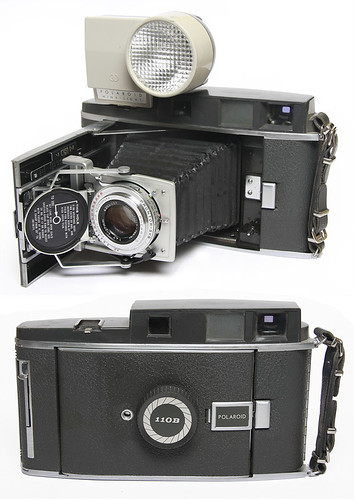Difference between revisions of "Polaroid Pathfinder"
(+links section with manual and diy back mod links) |
Hanskerensky (talk | contribs) (Removed Category: Category:US instant cameras as Category:Polaroid is its Sub-cat) |
||
| (5 intermediate revisions by 3 users not shown) | |||
| Line 8: | Line 8: | ||
}} | }} | ||
| − | '''Pathfinder''' was the name given a series of cameras manufactured by [[Polaroid]] and [[Yashica]] from the early 1950s until 1964. These models were the professional-market Polaroid camera, equipped with a fast and sharp lens and made with durable steel construction. Unlike other Polaroid cameras, the Pathfinders were set to expose the film fully manually, with no aid from | + | '''Pathfinder''' was the name given a series of cameras manufactured by [[Polaroid]] and [[Yashica]] from the early 1950s until 1964. These models were the professional-market Polaroid camera, equipped with a fast and sharp lens and made with durable steel construction. Unlike other Polaroid cameras, the Pathfinders were set to expose the film fully manually, with no aid from a light meter. This provides the photographer with precise control over the camera. Pathfinders used 40-series rollfilm, which produced an instant print of 7.2 x 9.5 cm. Even today, although rollfilm has since been discontinued, many photographers have found ways to use the Pathfinder. |
The focusing is with a bellows system like the previous models, but now uses a focusing knob found on the base of the bed / front cover. The bed contains a distance as well as a depth of field scale. There are two tripod sockets, the one on the bed base might require an adapter as the focus knob is in close proximity making mounting more difficult. | The focusing is with a bellows system like the previous models, but now uses a focusing knob found on the base of the bed / front cover. The bed contains a distance as well as a depth of field scale. There are two tripod sockets, the one on the bed base might require an adapter as the focus knob is in close proximity making mounting more difficult. | ||
| Line 26: | Line 26: | ||
|| | || | ||
{{Flickr_image | {{Flickr_image | ||
| − | |image_source= http://www.flickr.com/photos/ | + | |image_source= http://www.flickr.com/photos/ricksoloway/5514258163/in/pool-camerawiki/ |
| − | |image= | + | |image= http://farm6.staticflickr.com/5092/5514258163_c3595fdd49.jpg |
| − | |image_align= | + | |image_align= |
| − | |image_text= | + | |image_text= 110B with wink light |
| − | |image_by= | + | |image_by= Rick Soloway |
| − | |image_rights= | + | |image_rights= wp |
}} | }} | ||
|} | |} | ||
| Line 57: | Line 57: | ||
* [[Seikosha-SLV]] shutter, 1-1/500 plus Bulb. | * [[Seikosha-SLV]] shutter, 1-1/500 plus Bulb. | ||
| + | ==Modification== | ||
| + | With the discontinuation of type 40 instant film in the early 1990's, a few small companies like Marty Forscher's Professional Camera Repair, Four Designs Co. and [[NPC]] sold Pathfinder cameras modified to accept various modern films, most often the 110B model. These were also the most well known companies adapting Polaroid backs for use on many 35mm and medium format camera systems. | ||
| + | |||
| + | As of 2011, Littman Photography, Razzledog, and Eastcamtech are a few companies still doing conversions. These cameras can be made to accept conventional 4x5 inch sheet film, Polaroid 100-series packfilm, and even 120 rollfilm. Modified cameras with multi-format interchangeable backs and lenses have also been produced. There are also various websites detailing step by step methods to modify them yourself. | ||
| + | |||
| + | ==Lens detail== | ||
{{Flickr_image | {{Flickr_image | ||
| − | |image_source= http://www.flickr.com/photos/ | + | |image_source= http://www.flickr.com/photos/jordanjmartin/4889474979/in/pool-camerawiki/ |
| − | |image= http:// | + | |image= http://farm5.staticflickr.com/4102/4889474979_5c1db3d0a9_m.jpg |
| − | |image_align= | + | |image_align= left |
| − | |image_text= | + | |image_text= (110) 127mm Wollensak Raptar |
| − | |image_by= | + | |image_by= Jordan Martin |
|image_rights= wp | |image_rights= wp | ||
| + | }} | ||
| + | {{Flickr_image | ||
| + | |image_source= http://www.flickr.com/photos/37460295@N05/5810690648/in/pool-camerawiki/ | ||
| + | |image= http://farm3.staticflickr.com/2315/5810690648_cf1206dcef_m.jpg | ||
| + | |image_align= left | ||
| + | |image_text= (110A) Rodenstock Ysarex 127mm lens<BR>Prontor-SVS shutter | ||
| + | |image_by= Studioesper | ||
| + | |image_rights= nc | ||
}} | }} | ||
| − | == | + | {{Flickr_image |
| − | + | |image_source= http://www.flickr.com/photos/35243817@N06/3265364983/in/pool-camerawiki/ | |
| − | + | |image= http://farm4.staticflickr.com/3360/3265364983_8de049b4ec_m.jpg | |
| − | + | |image_align= left | |
| + | |image_text= (120) Yashica Yashinon 127mm<BR>Seikosha-SLV shutter | ||
| + | |image_by= tsuneo_fish | ||
| + | |image_rights= wp | ||
| + | }} | ||
| + | {{br}} | ||
==Links== | ==Links== | ||
* [http://www.cameramanuals.org/polaroid_pdf/polaroid_model_110a.pdf Polaroid 110A] / [http://www.cameramanuals.org/polaroid_pdf/polaroid_pathfinder_110.pdf 110B manual] at [http://www.orphancameras.com Mike Butkus' Orphan Cameras] | * [http://www.cameramanuals.org/polaroid_pdf/polaroid_model_110a.pdf Polaroid 110A] / [http://www.cameramanuals.org/polaroid_pdf/polaroid_pathfinder_110.pdf 110B manual] at [http://www.orphancameras.com Mike Butkus' Orphan Cameras] | ||
* [http://www.instantoptions.com/conversions/ DIY Polaroid Conversions page] at [http://www.instantoptions.com/ Instant Options] | * [http://www.instantoptions.com/conversions/ DIY Polaroid Conversions page] at [http://www.instantoptions.com/ Instant Options] | ||
| + | * [http://www.filmwasters.com/forum/index.php?topic=2083.0 Nekotech - Polaroid Pathfinder 120 (or maybe 110 too) to Pack-Film Conversion] - by Skorj at [http://www.filmwasters.com Filmwasters] | ||
| + | |||
[[Category: Yashica]] | [[Category: Yashica]] | ||
[[Category: Polaroid|Pathfinder]] | [[Category: Polaroid|Pathfinder]] | ||
| − | |||
[[Category: P]] | [[Category: P]] | ||
[[Category: Japan]] | [[Category: Japan]] | ||
[[Category: Scout|Pathfinder]] | [[Category: Scout|Pathfinder]] | ||
Latest revision as of 06:09, 6 September 2021
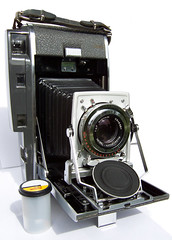
|
| Polaroid 110A image by Erich Z (Image rights) |
Pathfinder was the name given a series of cameras manufactured by Polaroid and Yashica from the early 1950s until 1964. These models were the professional-market Polaroid camera, equipped with a fast and sharp lens and made with durable steel construction. Unlike other Polaroid cameras, the Pathfinders were set to expose the film fully manually, with no aid from a light meter. This provides the photographer with precise control over the camera. Pathfinders used 40-series rollfilm, which produced an instant print of 7.2 x 9.5 cm. Even today, although rollfilm has since been discontinued, many photographers have found ways to use the Pathfinder.
The focusing is with a bellows system like the previous models, but now uses a focusing knob found on the base of the bed / front cover. The bed contains a distance as well as a depth of field scale. There are two tripod sockets, the one on the bed base might require an adapter as the focus knob is in close proximity making mounting more difficult.
Models
110
| ||
|
The original 110 featured:
- 127mm f/4.5 Wollensak Raptar lens
- Wollensak Rapax shutter, speeds 1-1/400 plus Bulb, T
- Coupled rangefinder mounted to top of camera near viewfinder
110A
- 127mm f/4.7 Rodenstock Ysarex lens
- Prontor SVS shutter, speeds 1-1/300 plus Bulb
- Self-timer
- Coupled rangefinder, viewfinder windows on top of camera
- Hinged lens cap
110B
Same as 110A, except:
- Coupled single-window range/viewfinder with parallax correction
- f/90 Pinhole lens cap
120
- Made by Yashica for non-USA markets
- 127mm, f/4.7, 4-element Yashinon lens
- Seikosha-SLV shutter, 1-1/500 plus Bulb.
Modification
With the discontinuation of type 40 instant film in the early 1990's, a few small companies like Marty Forscher's Professional Camera Repair, Four Designs Co. and NPC sold Pathfinder cameras modified to accept various modern films, most often the 110B model. These were also the most well known companies adapting Polaroid backs for use on many 35mm and medium format camera systems.
As of 2011, Littman Photography, Razzledog, and Eastcamtech are a few companies still doing conversions. These cameras can be made to accept conventional 4x5 inch sheet film, Polaroid 100-series packfilm, and even 120 rollfilm. Modified cameras with multi-format interchangeable backs and lenses have also been produced. There are also various websites detailing step by step methods to modify them yourself.
Lens detail
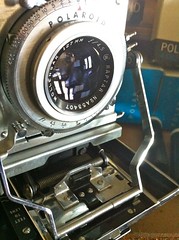
|
| (110) 127mm Wollensak Raptar image by Jordan Martin (Image rights) |
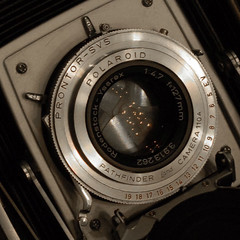
|
| (110A) Rodenstock Ysarex 127mm lens Prontor-SVS shutter image by Studioesper (Image rights) |
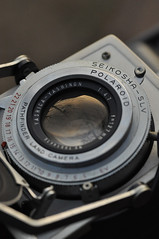
|
| (120) Yashica Yashinon 127mm Seikosha-SLV shutter image by tsuneo_fish (Image rights) |

